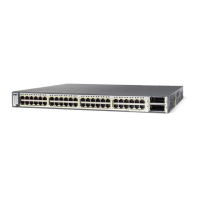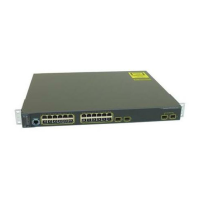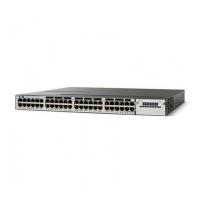CHAPTER
21-1
Catalyst 3750-X and 3560-X Switch Software Configuration Guide
OL-21521-01
21
Configuring MSTP
This chapter describes how to configure the Cisco implementation of the IEEE 802.1s Multiple STP
(MSTP) on the Catalyst 3750-X or 3560-X switch.
Note The multiple spanning-tree (MST) implementation is based on the IEEE 802.1s standard.
The MSTP enables multiple VLANs to be mapped to the s
ame spanning-tree instance, reducing the
number of spanning-tree instances needed to support a large number of VLANs. The MSTP provides for
multiple forwarding paths for data traffic and enables load-balancing. It improves the fault tolerance of
the network because a failure in one instance (forwarding path) does not affect other instances
(forwarding paths). The most common initial deployment of MSTP is in the backbone and distribution
layers of a Layer 2 switched network. This deployment provides the highly available network required
in a service-provider environment.
When the switch is in the MST mode, the Rapid Spanning Tree Protocol (RSTP), which is based on
IEEE 802.1w, is automatically enabled. The RSTP provides rapid convergence of the spanning tree
through e
xplicit handshaking that eliminates the IEEE 802.1D forwarding delay and quickly transitions
root ports and designated ports to the forwarding state.
Both MSTP and RSTP improve the spanning-tree operation and maintain backward compatibility with
equipment that is based on the (original) IEEE 802.1D s
panning tree, with existing Cisco-proprietary
Multiple Instance STP (MISTP), and with existing Cisco per-VLAN spanning-tree plus (PVST+) and
rapid per-VLAN spanning-tree plus (rapid PVST+). For information about PVST+ and rapid PVST+,
see Chapter 20, “Configuring STP.” For information about other spanning-tree fea
tures such as Port Fast,
UplinkFast, root guard, and so forth, see Chapter 22, “Configuring Optional Spanning-Tree Features.”
A switch stack appears as a single spanning-tree node t
o the rest of the network, and all stack members
use the same switch ID. Unless otherwise noted, the term switch refers to a standalone switch and to a
switch stack.
Note For complete syntax and usage information for the commands used in this chapter, see the command
reference for this release.
This chapter consists of these sections:
• Understanding MSTP, page 21-2
• Understanding RSTP, page 21-9
• Configuring MSTP Features, page 21-14
• Displaying the MST Configuration and Status, page 21-27
